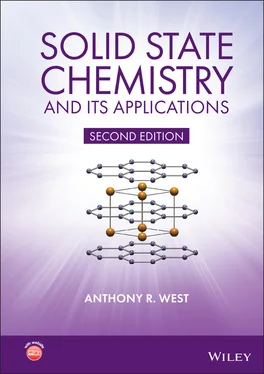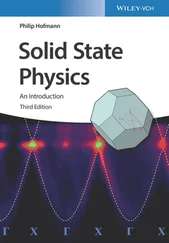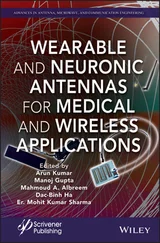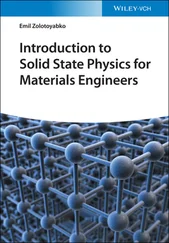5 Chapter 5Figure 5.1 Structural features of inorganic solids across the length scales...Figure 5.2 The electromagnetic spectrum.Figure 5.3 (a) Generation of Cu Kα X‐rays. A 1s electron is ionised; a 2p el...Figure 5.4 (a) Schematic design of a filament X‐ray tube. (b) Use of Ni to f...Figure 5.5 Schematic diagram of a synchrotron storage ring.Figure 5.6 (a) Lines on an optical grating act as secondary sources of light...Figure 5.7 Diffraction of light by an optical grating.Figure 5.8 Derivation of Bragg’s law.Figure 5.9 The X‐ray diffraction experiment.Figure 5.10 The different X‐ray diffraction techniques.Figure 5.11 The powder method.Figure 5.12 Formation of a cone of diffracted radiation.Figure 5.13 Schematic Debye–Scherrer photograph.Figure 5.14 (a) Theorem of a circle used to focus X‐rays. (b) Arrangement of...Figure 5.15 X‐ray powder diffraction patterns of (a) cristobalite and (b) gl...Figure 5.16 (a) Crystal monochromator M, source S and sample X, in a focusin...Figure 5.17 Section of the powder XRD patterns of BaTiO3 showing the cubic p...Figure 5.18 XRD patterns of some rock salt‐related phases (a) CoO, (b) LiCoO...Figure 5.19 (a) Scattering of X‐rays by electrons in an atom. (b) Form facto...Figure 5.20 (a) bcc α‐Fe; (b) (100) planes; (c) (200) planes.Figure 5.21 (a) (110) and (b) (111) planes in NaCl.Figure 5.22 (a, b) (100) planes for an orthogonal unit cell (α = β = γ = 90°...Figure 5.23 Calculated (red crosses), observed (green curves) and difference...Figure 5.24 Electron density map for NaCl.Figure 5.25 Antiferromagnetic superstructure in MnO, FeO and NiO, showing ps...Figure 5.26 Schematic neutron and powder XRD patterns for MnO for λ = 1.542...Figure 5.27 (a) Monoclinic unit cell in projection down b with (001) and (10...Figure 5.28 Construction of the reciprocal lattice; point Z represents the r...Figure 5.29 (a) Schematic section through the reciprocal lattice of a single...Figure 5.30 Reciprocal lattice of a body‐centred orthorhombic unit cell show...Figure 5.31 Reciprocal lattice of a face‐centred orthorhombic unit cell; lat...Figure 5.32 (a) zero layer, hk0, of a primitive hexagonal reciprocal lattice...Figure 5.33 Construction of the Ewald sphere of reflection showing (a) deriv...Figure 5.34 Formation of a schematic SAD pattern by a monochromatic electron...Figure 5.35 X‐ray powder diffraction patterns of (a) cristobalite and (b) Si...Figure 5.36 PDF results for SiO2 glass.Figure 5.37 The low‐r PDF region of the oxygen‐deficient perovskite, La0.5Ba...Figure 5.38 Broadening of X‐ray reflections due to small particle size....Figure 5.39 Part of a diffractometer trace for a mixture of MgO (small parti...
6 Chapter 6Figure 6.1 (a) Simplified ray diagram for an optical microscope. (b) Basic c...Figure 6.2 (a) The transmission of light along an optical fibre and (b) esca...Figure 6.3 Simplified ray diagram for an electron microscope showing diffrac...Figure 6.4 Working ranges of various techniques used for viewing solids. TEM...Figure 6.5 Some of the processes that occur on bombarding a sample with elec...Figure 6.6 Basic components of an electron microscope.Figure 6.7 Reflection and transmission signals in SEM and TEM modesFigure 6.8 Principle of the scanning electron microscope.Figure 6.9 Penetration and escape depths in SEM.Figure 6.10 Processes responsible for Auger electron emission.Figure 6.11 Auger spectra of (Pb0.4Sr0.6)TiO3/SiO2/Si layered structure afte...Figure 6.12 Cathodoluminescence: (a) excitation across the band gap; (b) rad...Figure 6.13 (a) Normalised CL spectra for undoped AlN and AlN doped with 0.2...Figure 6.14 High‐resolution electron micrograph of an intergrowth tungsten b...Figure 6.15 (a) TEM bright field micrograph of an ilmenite (Ilm) sample cont...Figure 6.16 Atomic resolution HAADF‐STEM image of Al72Ni20Co8 along the 10‐f...Figure 6.17 Schematic illustration of atomic resolution imaging and analysis...Figure 6.18 Principal regions of the electromagnetic spectrum and the associ...Figure 6.19 (a) Energy level transitions involved in IR and Raman spectrosco...Figure 6.20 IR spectra of (a) calcite, CaCO3, (b) NaNO3 and (c) gypsum, CaSO...Figure 6.21 Laser Raman spectra of (a) quartz and (b) cristobalite.Figure 6.22 Possible electronic transitions in a solid. These involve electr...Figure 6.23 Schematic of a typical UV/visible absorption spectrum.Figure 6.24 (a) The four mI states for a nucleus with spin I = 3/2 (i) in th...Figure 6.25 29Si NMR spectrum of xonotlite. Also shown schematically is t...Figure 6.26 Schematic 29Si NMR spectra of silicates containing different Q4...Figure 6.27 (a) Schematic ESR absorption peak, (b) the first derivative of t...Figure 6.28 (a) Flowsheet showing relations between various diffraction, mic...Figure 6.29 Al Kβ emission spectra of three Al‐containing materials....Figure 6.30 Variation of X‐ray absorption coefficient with wavelength for Cu...Figure 6.31 AEFS spectra of CuCl and CuCl2·2H2O.Figure 6.32 EXAFS spectrum of Cu.Figure 6.33 EXAFS‐derived partial RDFs for an amorphous Cu46Zr54 alloy: (a)...Figure 6.34 Origins of ESCA and Auger spectra.Figure 6.35 Schematic XPS and AES spectra of Na+ in a sodium‐containing soli...Figure 6.36 Schematic XPS 2p spectra of Na2S2O3 and Na2SO4. Each peak is a d...Figure 6.37 XPS spectrum of Cr 3s, 3p electrons in KCr3O8.Figure 6.38 XPS spectra for tungsten bronzes.Figure 6.39 (a) The Mössbauer effect. The energy of the γ‐rays is modified w...Figure 6.40 Chemical shifts in Fe‐containing compounds and minerals....Figure 6.41 Mössbauer spectrum of KFeS2 (a) quadrupole splitting above and (...Figure 6.42 Schematic TG curve for a single‐step decomposition reaction....Figure 6.43 Decomposition of CaCO3 in different atmospheres.Figure 6.44 The DTA method. Graph (b) results from the set‐up shown in (a) a...Figure 6.45 Schematic TG and DTA curves for kaolin minerals. Curves vary dep...Figure 6.46 Some schematic reversible and irreversible changes: (a) dehydrat...Figure 6.47 Schematic DTA curves showing melting of crystals on heating and...Figure 6.48 Use of DTA for phase diagram determination: (a) a simple binary...Figure 6.49 Schematic, stepwise decomposition of calcium oxalate hydrate by...
7 Chapter 7Figure 7.1 Binary join CaO–SiO2 in the ternary system Ca–Si–O. Note the meth...Figure 7.2 Schematic diagram showing stable, unstable and metastable conditi...Figure 7.3 Schematic P versus T phase diagram of a one‐component system....Figure 7.4 The system H2O.Figure 7.5 The system SiO2.Figure 7.6 Simple eutectic binary system.Figure 7.7 Principle of moments.Figure 7.8 Binary systems showing a compound AB melting congruently (a) and...Figure 7.9 Binary system showing compound AB with (a) an upper limit of stab...Figure 7.10 Binary system with a complete range of solid solutions.Figure 7.11 The plagioclase feldspar system, anorthite–albite.Figure 7.12 Binary solid solution systems with (a) thermal minima and (b) th...Figure 7.13 Simple eutectic system showing partial solid solubility of the e...Figure 7.14 The system Mg2SiO4‐Zn2SiO4.Figure 7.15 Binary system with partial solid solution formation.Figure 7.16 Binary system with incongruently melting compound and partial so...Figure 7.17 Simple eutectic system with solid–solid phase transitions.Figure 7.18 Binary solid solution systems with polymorphic phase transitions...Figure 7.19 Binary eutectic system with polymorphic transitions and partial...Figure 7.20 Liquid immiscibility domes in phase diagrams.Figure 7.21 MgO–SiO2 phase diagram.Figure 7.22 The Fe–C diagram.Figure 7.23 Partial diagram for lime‐rich compositions in the system CaO–SiO...Figure 7.24 Na–S phase diagram and open‐circuit cell voltage as a function o...Figure 7.25 Na2O–SiO2 phase diagram. N = Na2O, S = SiO2, N2S = Na4SiO4, NS =...Figure 7.26 Li2SiO3–SiO2 phase diagram. LS = Li2SiO3, LS2 = Li2Si2O5. The ex...Figure 7.27 Purification of Si by zone refining: impurities concentrate in t...Figure 7.28 ZrO2–Y2O3 phase diagram. M, T and C refer to the monoclinic, tet...Figure 7.29 Bi2O3–Fe2O3 phase diagram.Figure 7.30 Summary of the changes that can occur in a single‐phase material...Figure 7.31 Triangular grid or composition triangle used to represent the co...Figure 7.32 Two possible arrangements of compatibility triangles in a simple...Figure 7.33 Ternary systems containing ranges of binary solid solutions. Num...Figure 7.34 Possible doping mechanisms with charge compensation and solid so...Figure 7.35 Ternary phase diagrams to represent BaTiO3 which has lost some o...Figure 7.36 Representation of a 4‐component, quaternary phase diagram as a p...Figure 7.37 (a) Simple ternary eutectic system showing univariant curves and...Figure 7.38 Isothermal sections of Fig. 7.37(a) at temperatures T 1 and T 2.Figure 7.39 Possible melting relations in a ternary system that contains a c...Figure 7.40 The joins BC‐A in Fig. 7.39.Figure 7.41 Ternary systems containing (a) an incongruently melting binary p...Figure 7.42 (a) Congruently‐melting phase BC with a lower limit of stability...Figure 7.43 Self‐consistency between melting behaviour and subsolidus compat...Figure 7.44 Solid–liquid compatibility relations in ternary systems with a b...Figure 7.45 (a) Crystallisation pathway in a ternary system with a binary so...Figure 7.46 (a–d) Phase diagram CaO–Al2O3–SiO2 separated into parts highligh...Figure 7.47 Transformation from structure (a) to any of structures (b–d) req...Figure 7.48 Displacive phase transition between (a) rock salt and (b) CsCl s...Figure 7.49 (a) Ordered cation arrangement in tetragonal LiFeO2; a = 4.057,...Figure 7.50 (a) Ferroelectric KH2PO4 and (b) antiferroelectric NH4H2PO4; • P...Figure 7.51 (a–f) Temperature‐dependence of thermodynamic properties of phas...Figure 7.52 Thermodynamic properties of phases involved in second‐order phas...Figure 7.53 Specific heat of crystalline quartz.Figure 7.54 Schematic free energy–temperature diagrams showing polymorphic t...Figure 7.55 Temperature dependence of the transition rates for a typical fir...Figure 7.56 Difference in free energy between polymorphs I and II at (a) T c...Figure 7.57 Change in free energy of nuclei as a function of radius.Figure 7.58 Critical size of nuclei as a function of temperature.Figure 7.59 Effect of temperature on nucleation rate, R.Figure 7.60 Arrhenius plot for the rate of transition β ↔ γ in Li2ZnSiO4....Figure 7.61 Time – temperature – transformation, TTT diagram for the transit...Figure 7.62 Topotactic mechanism for the transformation between (a) β and (b...Figure 7.63 Formation of a martensite plate within a parent austenite crysta...Figure 7.64 Monoclinic (M)–tetragonal (T) martensitic transformation in zirc...Figure 7.65 Two possible orientations for NH4 + ions in phase II of NH4Cl....
Читать дальше












